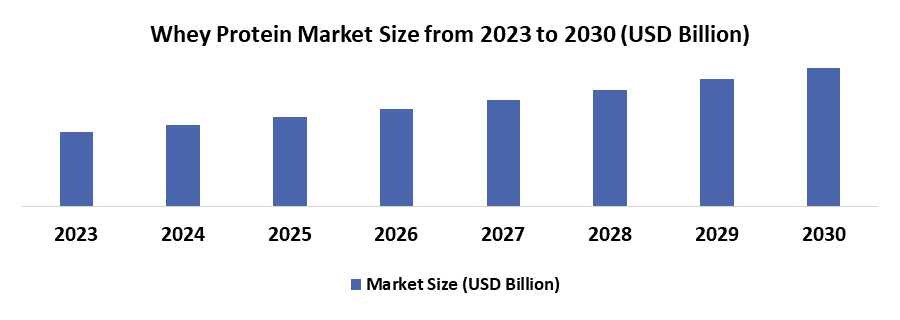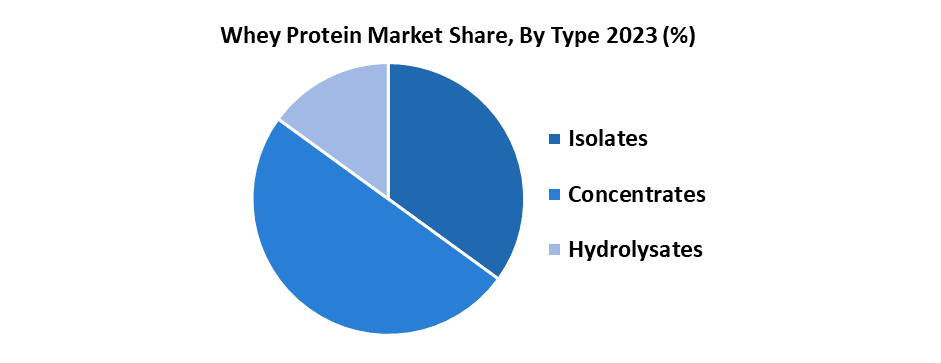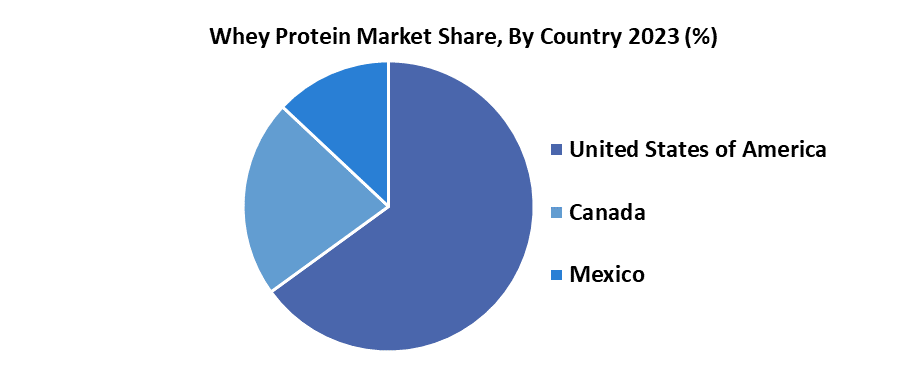Whey Protein Market: Global Industry Analysis and Forecast (2024-2030)
The Whey Protein Market size was valued at USD 8.86 Bn. in 2023 and the total Global Whey Protein revenue is expected to grow at a CAGR of 9.42% from 2024 to 2030, reaching nearly USD 16.64 Bn. by 2030.
Format : PDF | Report ID : SMR_2153
Whey Protein Market Overview
The global whey protein market is experiencing robust growth, driven by increasing health consciousness and the rising demand for high-protein diets. Whey protein, derived from milk during the cheese-making process, is a complete protein rich in essential amino acids, making it highly desirable across various applications. The market is segmented into sports nutrition, dietary supplements, infant formula, food additives, beverages, and animal feed, each contributing to the overall market expansion.
Sports nutrition leads the market, accounting for approximately 35% of the share, followed by dietary supplements and infant formula. The market's growth is bolstered by advancements in food processing technologies, expanding distribution channels, and a surge in fitness and wellness trends globally. Additionally, innovations in product formulations and the introduction of organic and natural variants are further propelling the market. As consumers become increasingly aware of the benefits of protein intake, the whey protein market is poised for continued expansion and diversification.
- The functional foods market, which heavily utilizes WPC, is expected to reach USD 275.77 billion by 2025, growing at a CAGR of 7.9%.
To get more Insights: Request Free Sample Report
Whey Protein Market Dynamics
Surging Demand and Innovation in Health and Wellness
The whey protein market is experiencing robust growth driven by rising health consciousness and the increasing popularity of fitness and wellness lifestyles. Consumers are turning to whey protein for its high-quality, complete protein profile, which supports muscle growth, weight management, and overall health. This surge is particularly evident among athletes, bodybuilders, and health enthusiasts seeking efficient ways to meet their protein needs. Innovations in product formulations, such as flavored powders, ready-to-drink shakes, and protein bars, are expanding market appeal. Additionally, the growing trend towards clean label products and natural ingredients is prompting manufacturers to focus on organic and grass-fed whey options. As awareness of the health benefits of whey protein spreads globally, the market is poised for continued expansion and diversification.

Quality Issues and Production Hurdles
The whey protein market faces significant challenges in production quality and efficiency, particularly in the manufacturing of dried whey powders. High levels of amorphous lactose led to caking, reducing powder yield during spray drying. This issue is compounded by the hygroscopic nature of whey, which decreases efficiency and quality. Studies highlight the need for reducing mineral and lactic acid content, and optimizing lactose pre-crystallization processes to mitigate these issues. For example, effective pre-crystallization decreases caking during storage, enhancing product quality. With the global whey protein market valued at around $8.86 billion in 2023 and projected to reach $16.64 billion by 2030, addressing these production challenges is crucial for sustaining growth and meeting market demand.
Whey Protein Market Segment Analysis
By Type, Whey Protein Concentrates (WPC) held the largest market share in the whey protein segment, accounting for approximately 50% of the market in 2023. This dominance is attributed to their cost-effectiveness and versatility, making them accessible to a broad consumer base, including fitness enthusiasts, health-conscious individuals, and the general population. WPC typically contains 70-80% protein, with the remaining composition including fats, lactose, and minerals, providing a balanced nutritional profile.
This type of whey protein is widely used in nutritional supplements, functional foods, beverages, and even infant formula due to its affordability and nutritional benefits. The market for WPC is driven by the increasing demand for protein-enriched foods and beverages, the rise of health and fitness trends, and the growing awareness of the benefits of protein in the diet. Additionally, its application in food fortification is expanding as consumers seek more nutritious and functional food options, further boosting its market presence.
- WPC is less expensive compared to Whey Protein Isolates (WPI) and Whey Protein Hydrolysates (WPH), making it more accessible to a wider range of consumers.
- WPC is extensively used in nutritional supplements, sports nutrition products, functional foods, beverages, and infant formula.
- According to a stellar analysis, 60% of consumers reported increasing their protein intake as part of their dietary habits, with WPC being a popular choice thanks to its balanced nutritional profile and affordability.

Whey Protein Market Regional Analysis
North America has dominated the Whey Protein Market, which held the largest market share accounting for 35% in 2023, the region is expected to grow during the forecast period and maintain its dominance by 2030. North America holds the largest share of the global whey protein market, driven by the high consumption of dietary supplements, functional foods, and sports nutrition products. The United States, in particular, is a major consumer thanks to a strong fitness culture and significant demand for protein-rich diets. The region benefits from advanced food processing technology and a high level of health and fitness awareness among consumers. Additionally, the presence of major whey protein manufacturers and a robust distribution network further bolster the market.

Europe is a significant market for whey protein, characterized by a high demand for nutritional supplements and functional foods. Countries like Germany, the UK, and France lead in consumption. The whey protein market is driven by the rising trend of healthy lifestyles and dietary supplements, along with stringent regulatory standards ensuring high product quality. Additionally, the growing elderly population in Europe increases the demand for protein supplements aimed at maintaining muscle mass and overall health.
The Asia-Pacific region is the fastest-growing market for whey protein, fueled by increasing health consciousness and a growing middle class with disposable income. Countries such as China, India, Japan, and Australia are key whey protein markets. The rising adoption of Western dietary habits, increased participation in fitness activities, and the booming food and beverage industry contribute to this growth. Additionally, the expanding e-commerce sector makes whey protein products more accessible to consumers in this region.
Whey Protein Market Competitive Landscape
The whey protein market's competitive landscape is characterized by intense rivalry among key players, each striving for innovation and market share. Major companies lead the industry with advanced whey protein products catering to the growing demand for high-protein foods. These firms are investing heavily in research and development to create differentiated offerings, such as specialized whey protein concentrates and isolates, to meet diverse consumer needs. Additionally, strategic partnerships, mergers, and acquisitions are common as companies seek to expand their global reach and enhance their product portfolios. This competitive environment drives continuous advancements and ensures a wide variety of high-quality whey protein products are available to consumers for instance,
5 Jan 2024, Lactalis has unveiled a solar thermal power plant dedicated to sustainable whey production, marking a significant step towards eco-friendly manufacturing practices.
9 November 2023, Fonterra's breakthrough whey protein concentrate, Pro-Optima™ Grade A fWPC, revolutionizes cultured products, catering to the growing demand for high-protein foods. Research shows 65% of consumers seek more protein for its health benefits. This innovation by Fonterra's Research and Development Centre ensures high-quality, protein-rich yoghurts made with US milk, meeting the needs of health-conscious consumers.
7 November 2023, Arla Foods Ingredients is addressing the rising demand for high-protein products in Africa and the Middle East, where high-protein claims have grown by 17.64% annually. At Gulfood Manufacturing in Dubai, they have showcased innovative whey protein concepts, including high-protein ice cream, fermented protein drinks, and clear protein-enriched juice, emphasizing quality and taste.
|
Whey Protein Market Scope |
|
|
Market Size in 2023 |
USD 8.86 Bn |
|
Market Size in 2030 |
USD 16.64 Bn |
|
CAGR (2024-2030) |
9.42% |
|
Historic Data |
2018-2022 |
|
Base Year |
2023 |
|
Forecast Period |
2024-2030 |
|
Segments |
by Application Sports Nutrition Dietary Supplements Infant Formula Food Additives Beverages Feed |
|
by Type Isolates Concentrates Hydrolysates |
|
|
Regional Scope |
North America- United States, Canada, and Mexico Europe – UK, France, Germany, Italy, Spain, Sweden, Austria, and Rest of Europe Asia Pacific – China, India, Japan, South Korea, Australia, ASEAN, Rest of APAC Middle East and Africa - South Africa, GCC, Egypt, Nigeria, Rest of the Middle East and Africa South America – Brazil, Argentina, Rest of South America |
Key Player in the Whey Protein Market
- Hilmar Cheese Company, Inc.
- Saputo Inc.
- Glanbia plc
- Fonterra Co-operative Group Ltd.
- Arla Foods
- Alpavit
- Wheyco GmbH
- Milk Specialties
- Carbery Group
- LACTALIS Ingredients
- Olam International
- Davisco Foods International, Inc.
- Leprino Foods Company
- Nestle S.A.
- Nutricia (Danone)
- Abbott
- Sanofi S.A.
- Now Health Group, Inc.
- Nutiva Inc
- The Simply Good Food Co
- Iovate Health Sciences International Inc.
- MusclePharm Corporation
- Kerry Group Plc
- CytoSport, Inc.
- Reliance Vitamin Company, Inc.
- Herbalife Nutrition, Inc.
- General Nutrition Centers (GNC) Holdings, Inc.
- Orgain Inc.
- True Nutrition
- XX Inc
Frequently Asked Questions
The growth of the whey protein market is driven by several key factors, increasing health and fitness awareness among consumers, amino acid profile and high bioavailability, and weight management.
Investors capitalize on opportunities in the whey protein market by focusing on several strategic areas. Launching of a new product formulation, marketing on e-commerce and direct-to-consumer sales benefits different opportunities in the whey protein market.
The Market size was valued at USD 8.86 billion in 2023 and the total Market revenue is expected to grow at a CAGR of 9.42% from 2024 to 2030, reaching nearly USD 16.64 billion.
1. Whey Protein Market: Research Methodology
2. Whey Protein Market: Executive Summary
3. Whey Protein Market: Competitive Landscape
4. Potential Areas for Investment
4.1. Stellar Competition Matrix
4.2. Competitive Landscape
4.3. Key Players Benchmarking
4.4. Market Structure
4.4.1. Market Leaders
4.4.2. Market Followers
4.4.3. Emerging Players
4.5. Consolidation of the Market
5. Whey Protein Market: Dynamics
5.1. Market Driver
5.1.1. Increasing Consumer Awareness
5.1.2. Innovation in Product Offerings
5.2. Market Trends
5.3. Market Restraints
5.4. Market Opportunities
5.5. Market Challenges
5.6. PORTER’s Five Forces Analysis
5.7. PESTLE Analysis
5.8. Strategies for New Entrants to Penetrate the Market
5.9. Regulatory Landscape by Region
5.9.1. North America
5.9.2. Europe
5.9.3. Asia Pacific
5.9.4. Middle East and Africa
5.9.5. South America
6. Whey Protein Market Size and Forecast by Segments (by Value Units)
6.1. Whey Protein Market Size and Forecast, by Application (2023-2030)
6.1.1. Sports Nutrition
6.1.2. Dietary Supplements
6.1.3. Infant Formula
6.1.4. Food Additives
6.1.5. Beverages
6.1.6. Feed
6.2. Whey Protein Market Size and Forecast, by Type (2023-2030)
6.2.1. Isolates
6.2.2. Concentrates
6.2.3. Hydrolysates
6.3. Whey Protein Market Size and Forecast, by Region (2023-2030)
6.3.1. North America
6.3.2. Europe
6.3.3. Asia Pacific
6.3.4. Middle East and Africa
6.3.5. South America
7. North America Whey Protein Market Size and Forecast (by Value Units)
7.1. North America Whey Protein Market Size and Forecast, by Application (2023-2030)
7.1.1. Sports Nutrition
7.1.2. Dietary Supplements
7.1.3. Infant Formula
7.1.4. Food Additives
7.1.5. Beverages
7.1.6. Feed
7.2. North America Whey Protein Market Size and Forecast, by Type (2023-2030)
7.2.1. Isolates
7.2.2. Concentrates
7.2.3. Hydrolysates
7.3. North America Whey Protein Market Size and Forecast, by Country (2023-2030)
7.3.1. United States
7.3.2. Canada
7.3.3. Mexico
8. Europe Whey Protein Market Size and Forecast (by Value Units)
8.1. Europe Whey Protein Market Size and Forecast, by Application (2023-2030)
8.1.1. Sports Nutrition
8.1.2. Dietary Supplements
8.1.3. Infant Formula
8.1.4. Food Additives
8.1.5. Beverages
8.1.6. Feed
8.2. Europe Whey Protein Market Size and Forecast, by Type (2023-2030)
8.2.1. Isolates
8.2.2. Concentrates
8.2.3. Hydrolysates
8.3. Europe Whey Protein Market Size and Forecast, by Country (2023-2030)
8.3.1. UK
8.3.2. France
8.3.3. Germany
8.3.4. Italy
8.3.5. Spain
8.3.6. Sweden
8.3.7. Austria
8.3.8. Rest of Europe
9. Asia Pacific Whey Protein Market Size and Forecast (by Value Units)
9.1. Asia Pacific Whey Protein Market Size and Forecast, by Application (2023-2030)
9.1.1. Sports Nutrition
9.1.2. Dietary Supplements
9.1.3. Infant Formula
9.1.4. Food Additives
9.1.5. Beverages
9.1.6. Feed
9.2. Asia Pacific Whey Protein Market Size and Forecast, by Type (2023-2030)
9.2.1. Isolates
9.2.2. Concentrates
9.2.3. Hydrolysates
9.3. Asia Pacific Whey Protein Market Size and Forecast, by Country (2023-2030)
9.3.1. China
9.3.2. S Korea
9.3.3. Japan
9.3.4. India
9.3.5. Australia
9.3.6. Indonesia
9.3.7. Malaysia
9.3.8. Vietnam
9.3.9. Taiwan
9.3.10. Bangladesh
9.3.11. Pakistan
9.3.12. Rest of Asia Pacific
10. Middle East and Africa Whey Protein Market Size and Forecast (by Value Units)
10.1. Middle East and Africa Whey Protein Market Size and Forecast, by Application (2023-2030)
10.1.1. Sports Nutrition
10.1.2. Dietary Supplements
10.1.3. Infant Formula
10.1.4. Food Additives
10.1.5. Beverages
10.1.6. Feed
10.2. Middle East and Africa Whey Protein Market Size and Forecast, by Type (2023-2030)
10.2.1. Isolates
10.2.2. Concentrates
10.2.3. Hydrolysates
10.3. Middle East and Africa Single-Use Filtration Assembly Market Size and Forecast, by Country (2023-2030)
10.3.1. South Africa
10.3.2. GCC
10.3.3. Egypt
10.3.4. Nigeria
10.3.5. Rest of ME&A
11. South America Whey Protein Market Size and Forecast (by Value Units)
11.1. South America Whey Protein Market Size and Forecast, by Application (2023-2030)
11.1.1. Sports Nutrition
11.1.2. Dietary Supplements
11.1.3. Infant Formula
11.1.4. Food Additives
11.1.5. Beverages
11.1.6. Feed
11.2. South America Whey Protein Market Size and Forecast, by Type (2023-2030)
11.2.1. Isolates
11.2.2. Concentrates
11.2.3. Hydrolysates
11.3. South America Whey Protein Market Size and Forecast, by Country (2023-2030)
11.3.1. Brazil
11.3.2. Argentina
11.3.3. Rest of South America
12. Company Profile: Key players
12.1. Hilmar Cheese Company, Inc.
12.1.1. Company Overview
12.1.2. Financial Overview
12.1.3. Business Portfolio
12.1.4. SWOT Analysis
12.1.5. Business Strategy
12.1.6. Recent Developments
12.2. Saputo Inc.
12.3. Glanbia plc
12.4. Fonterra Co-operative Group Ltd.
12.5. Arla Foods
12.6. Alpavit
12.7. Wheyco GmbH
12.8. Milk Specialties
12.9. Carbery Group
12.10. LACTALIS Ingredients
12.11. Olam International
12.12. Davisco Foods International, Inc.
12.13. Leprino Foods Company
12.14. Nestle S.A.
12.15. Nutricia (Danone)
12.16. Abbott
12.17. Sanofi S.A.
12.18. Now Health Group, Inc.
12.19. Nutiva Inc
12.20. The Simply Good Food Co
12.21. Iovate Health Sciences International Inc.
12.22. MusclePharm Corporation
12.23. Kerry Group Plc
12.24. CytoSport, Inc.
12.25. Reliance Vitamin Company, Inc.
12.26. Herbalife Nutrition, Inc.
12.27. General Nutrition Centers (GNC) Holdings, Inc.
12.28. Orgain Inc.
12.29. True Nutrition
12.30. XX Inc
13. Key Findings
14. Industry Recommendations
















